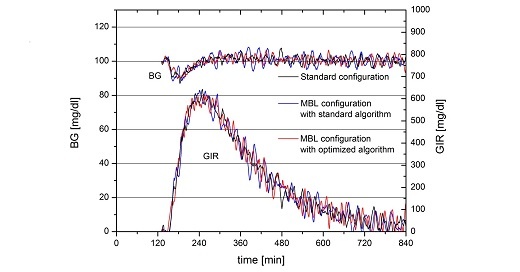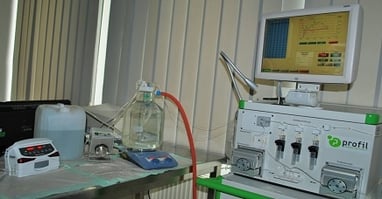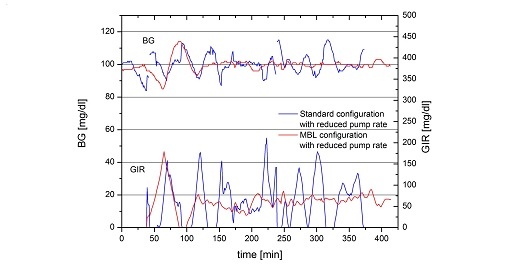Glucose Clamps
The euglycemic, hyperinsulinemic glucose clamp is the gold standard for the determination of pharmacokinetic and pharmacodynamic (PK/PD) effects of (new) anti-diabetic drugs, in particular insulins. In a typical glucose clamp experiment, a drug-induced decline in blood glucose (BG) concentrations is prevented by infusing glucose at a variable rate, so that BG is "clamped" at a pre-determined target level (TL).
Glucose clamps can be done either manually or in an automated fashion. In manual clamps the investigator performs BG measurements and manually adjusts glucose infusion rates (GIR) every 3–10 minutes, whereas in automated clamps, a device measures BG continuously and adapts GIR every minute according to an implemented algorithm. While modern devices such as ClampArt® have improved the quality of continuous BG-measurements and the accuracy of glucose delivery, they still need a relatively high amount of blood (about 2 ml/hour) for their continuous BG measurements. This blood loss is a major challenge in particular for studies with ultra-long acting basal insulins requiring multiple clamps with duration of up to 48 hours post-dosing in one individual.
As safety of study participants is the top priority in clinical trials, total individual blood loss in short-term PK/PD studies must not substantially exceed 500 mL. A blood loss of approximately 100 mL (2ml/h) per clamp therefore restricts the number of clamps per individual, in particular if combined with additional blood sampling for PK-measurements.
We therefore developed a minimal blood loss (MBL) configuration for the ClampArt® device which affects both the speed of the pumps and the control algorithm.
Methods
The MBL configuration aimed at reducing blood loss by 50% (i.e. to 1 mL per hour) was implemented in the control software of the ClampArt® device, a proprietary development of Profil, Neuss, Germany for automated glucose clamps which is CE-marked and licensed for use in Europe. ClampArt® uses a fully validated state-of-the-art technology to perform BG measurements and GIR-adaptations every minute.
Reducing the blood demand for the BG-measurements of ClampArt® can easily be achieved by decreasing the speed of the pump transferring blood from the subject to the glucose sensor. However, the reduced pump rate increases the lag time between blood sampling and BG measurement. If this higher lag time is not accounted for in the algorithm for the GIR-calculation, GIR might be changed too slowly leading to higher oscillations in both GIR and BG and higher deviations of BG from the target levels.
We therefore optimized the algorithm settings for the new MBL-configuration of ClampArt® via in-silico numerical simulations. The new settings were then validated in in-vitro experiments and finally tested in-vivo in a clinical euglycemic clamp study.
Numerical Simulations
The reduction in pump rate in order to lower the ClampArt®-induced blood loss to 1 mL/hour increases the lag time between blood sampling and BG measurement from approximately two minutes in the original set-up to approximately three minutes in the MBL-configuration.

The increased lag time enlarges the GIR- and BG-oscillations using the original algorithm (blue curve) with respect to the standard configuration (black line).
We therefore optimized the configuration of the algorithms’ parameters for the MBL configuration via numerical simulations resulting in less fluctuation in both GIR and BG (red curve). The resulting fluctuations are comparable with the fluctuations obtained with the standard configuration using the original algorithm and pump settings for a blood loss of 2 mL per hour (black line).
In-vitro Experiments
The new MBL configuration with the optimized algorithm was tested in in-vitro studies. In these studies, ClampArt® determined the glucose concentration in a 5 L container filled with a glucose solution using a setup as close as possible to the original setting (same pumps, same tubing, same catheter,…). 
The blood glucose lowering effect of a short-acting insulin was simulated by infusing water into the container (i.e. diluting the glucose solution in the container) using a programmable precision pump. The time-action profiles of various insulin formulations (basal, rapid-acting) were taken from previous glucose clamp experiments done at Profil, Neuss, Germany and programmed into this pump.
Several in-vitro glucose clamps were performed using the MBL configuration with reduced pump rates. The measured glucose concentrations and the applied GIRs were compared between the standard algorithm and the new algorithm optimized for the MBL configuration.

As illustrated in the figure, a basal insulin high oscillations in both BG and GIR were observed with the standard algorithm in the new MBL configuration (blue line). These oscillations were markedly reduced with an optimized algorithm for the MBL configuration (red line).
Clinical Study
The validation of the new MBL configuration using the optimized algorithm was part of a clinical pilot study (in total 30 clamps) in healthy subjects who received insulin glargine s.c. (0.6 U/kg) under euglycemic clamp conditions.
Clamp quality [2] in all MBL-clamps with the optimized algorithm was compared with that obtained in 302 previous clamps with insulin glargine (0.4 U/kg) using the standard setup (2 mL blood loss per hour).
|
Clamp Quality Parameter |
Standard configuration |
MBL configuration |
|
Technical downtime |
4.6% ± 3.8% |
1.6% ± 1.0% |
|
Deviation from target |
-0.2mg/dl ± 0.2mg/dl |
-0.3mg/dl ± 0.1mg/dl |
|
Precision |
3.8% ± 1.3% |
3.1% ± 1.3% |
All measured clamp quality parameters with the MBL setup are similar to those obtained with the standard setup.
Conclusion and Outlook
The new MBL configuration of ClampArt® using the optimized algorithm reduces the device-induced blood loss in automated glucose clamps by 50% to 1mL per hour without compromising clamp quality.
This new configuration allows more options for future clinical investigations with clamps of long duration, e.g. for the PD evaluation of long-acting basal insulins.
Learn more about glucose clamping by watching this free online seminar.




